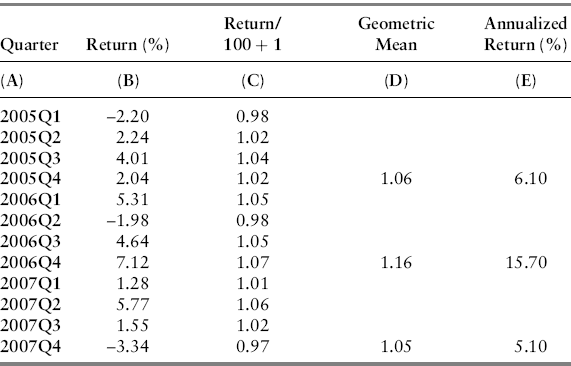Estimating Returns
The total return on an investment in any security is the percentage change in the value of the asset including dividends over a specific interval of time. Assuming asset value is captured in the market price P and dividends by d, then the one period total return, r1, is equal to ![]() percent, in which the subscripts index time. For simplicity, we will ignore dividends, which gives us the price return, which, in decimal form, is equal to
percent, in which the subscripts index time. For simplicity, we will ignore dividends, which gives us the price return, which, in decimal form, is equal to ![]() . Thus,
. Thus, ![]() is the gross return (the return plus the initial one-dollar outlay in the security) on the investment for one period, and
is the gross return (the return plus the initial one-dollar outlay in the security) on the investment for one period, and ![]() is the net return; it is the return on a $1 investment. We can geometrically link returns to get the time equivalent of a longer-term investment. For example, suppose that the period under study is one month and that
is the net return; it is the return on a $1 investment. We can geometrically link returns to get the time equivalent of a longer-term investment. For example, suppose that the period under study is one month and that ![]() is therefore the one-month return. We can annualize this return by assuming the investment returns this amount in each month. Compounding this for one year is a product yielding the amount:
is therefore the one-month return. We can annualize this return by assuming the investment returns this amount in each month. Compounding this for one year is a product yielding the amount:
![]()
Here, ![]() is the monthly return, while
is the monthly return, while ![]() is the annualized equivalent. On the other hand, we may observe a time series of past monthly returns (called trailing returns), which we geometrically link to estimate an annualized figure, that is, the previous 12 monthly returns generate an annual return given by:
is the annualized equivalent. On the other hand, we may observe a time series of past monthly returns (called trailing returns), which we geometrically link to estimate an annualized figure, that is, the previous 12 monthly returns generate an annual return given by:
![]()
We can similarly link quarterly returns to estimate an annual equivalent, for example, ![]() , and we can do the same for weekly, daily, or any frequency for that matter, to achieve a lower frequency equivalent return. Focusing once again on monthly gross returns, annualization is a compounded return that is the product of monthly relative prices, each measuring price appreciation from the previous month, that is, by generalizing from the fact that if
, and we can do the same for weekly, daily, or any frequency for that matter, to achieve a lower frequency equivalent return. Focusing once again on monthly gross returns, annualization is a compounded return that is the product of monthly relative prices, each measuring price appreciation from the previous month, that is, by generalizing from the fact that if ![]() , then the following must also be true:
, then the following must also be true:

Upon canceling, this reduces to the following, which is consistent with our definition of gross return given earlier.

This suggests that we can calculate the gross return over any period by taking the ratio of the market values and ignoring all intermediate market values. Similarly, we can solve for any intervening periodic average return by using the power rule; in this case, if the annual return is ![]() , then the geometric average monthly return
, then the geometric average monthly return ![]() must be
must be
![]()
For example, the average monthly return necessary to compound to a 15 percent annual return must be approximately 1.17 percent per month:
![]()
Table 1.1 Russell 3000 Dom Eq Index
| Date | Return (%) |
| 2005Q1 | –2.20 |
| 2005Q2 | 2.24 |
| 2005Q3 | 4.01 |
| 2005Q4 | 2.04 |
| 2006Q1 | 5.31 |
| 2006Q2 | –1.98 |
| 2006Q3 | 4.64 |
| 2006Q4 | 7.12 |
| 2007Q1 | 1.28 |
| 2007Q2 | 5.77 |
| 2007Q3 | 1.55 |
| 2007Q4 | –3.34 |
Table 1.2 Geometric Returns

